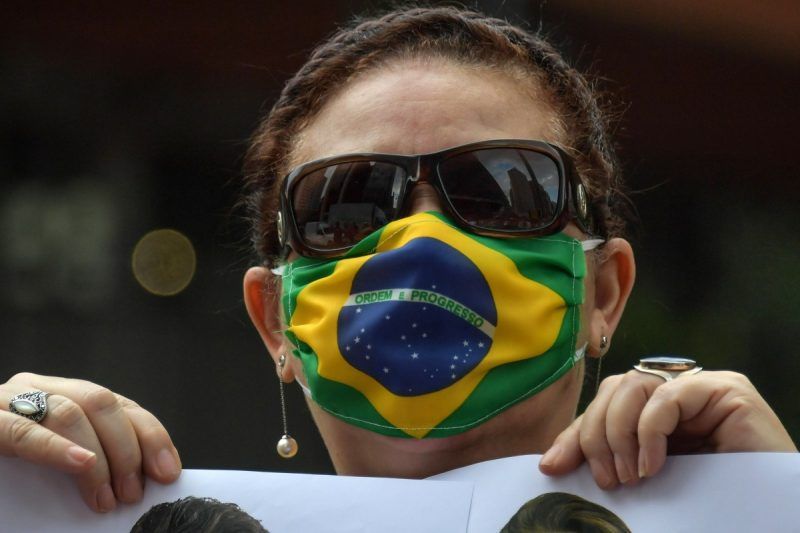
Brazil’s government is in the running for the world’s worst coronavirus response. While many world leaders have imposed lockdowns or stay-at-home orders, President Jair Bolsonaro has launched a $1 million advertising campaign against social distancing — encouraging people to go to church and businesses to stay open.
Meanwhile, on May 1, Brazil reported 91,589 cases and 6,329 deaths — twice the number of the previous week and probably a severe underestimate.
Co-starring in this drama has been Luiz Mandetta, Brazil’s recently fired health minister. A conservative politician who once voted for a 20-year freeze on government health spending, Mandetta’s stance on the pandemic has rebranded him as a Fauci figure. Like Fauci, the voice of reason within the U.S. covid-19 response team, Mandetta gave technocratic daily news briefings and advocated for self-isolation. Bolsonaro fired him on April 17.
But behind the scenes, a hidden army of bureaucrats has been working diligently to prepare Brazil for the pandemic: The national public health system, known as SUS (Sistema Único de Saúde), has quietly been fighting to distribute tests and to help the World Health Organization develop a treatment. If Brazil avoids some of the worst-case predictions, the national public health system will be to thank.
Here’s what recent research tells us about the SUS.
What is the SUS?
Created in 1989, Brazil’s SUS is one of the largest government-run public health-care systems in the world. Its family health program alone includes 40,000 clinics, employs more than 265,000 community-health-care workers, and serves nearly 67 percent of the population with regular house visits. Because of such programs, Brazil has recorded among the world’s largest improvements in health outcomes in recent decades.
The SUS has also suffered from severe funding shortfalls, which worsened significantly after 2016, when conservative politicians backed by private business interests imposed a 20-year freeze on the SUS budget. The result of such austerity measures have been systemic problems that limit Brazil’s coronavirus response capacity. Public hospitals were already short on beds for patients; stocks of medications often run out; and doctors’ appointments often involve long waits.
Still, behind the scenes, Brazil’s public health agencies have actively taken measures to combat the epidemic, despite Bolsonaro’s stance.
By mid-April, government health-care workers had given flu vaccines to over 90 percent of the nation’s elderly — helping to keep hospital beds and ventilators free while reducing the potential need for coronavirus tests.
The SUS provides critical infrastructure for responding to the pandemic with testing, tracing and social isolation. SUS community health workers already pay regular visits to every home in their tract of 75 to 200 households. During visits, they educate people about health and refer sick people to clinics — serving as conduits between doctors and patients and building community trust in the health system. Once reliable tests are widely available, the SUS community health infrastructure can help Brazil take that approach.
The SUS has also had a leading international role in fighting covid-19. Along with the U.S. Centers for Disease Control and Prevention, Brazil’s Fiocruz national health institute has been designated by the WHO as one of two covid-19 reference centers for the Americas. Thousands of epidemiologists and other specialists, educated across Brazil’s network of 40 public health schools and working across the national epidemiological surveillance system, have been training public health workers across Latin America in covid-19 diagnosis.
Social movements created the SUS
Brazil’s national public health system exists because of a public health mobilization known as the Sanitarista movement. This movement first emerged in the 1970s, and it brought together a diverse array of activists concerned with extreme inequalities in access to health care, from medical professionals to poor people’s movements. The Sanitarista movement achieved its most famous success during the 1988 constituent assembly, which created a new constitution for Brazil, based on the principles of social democracy. During the assembly, Sanitaristas persuaded participants to redefine health as a basic human right and to guarantee universal access to health services. This laid the legal groundwork for what became known as the SUS.
Brazil’s public health movement continued to mobilize over the next three decades. During this more prolonged and hidden campaign that focused on shaping health policy implementation, the movement transformed the constitutional right to health into the physical structure of a government-run health system.
The movement pursued its goals through transforming the bureaucracy. While activists mobilized politicians from diverse parties to support their goals, they also built strong alliances with bureaucrats. As a new book by sociologist Christopher L. Gibson describes, activists also took government jobs in key decision-making positions in the health-care bureaucracy, nationally, regionally and locally. The movement also advocated for participatory institutions, as political scientist Lindsay Mayka’s research shows, that gave activists a new avenue for protecting the health system by giving citizens and civil society groups an official voice in policy decisions.
As my new book on Brazil’s response to the AIDS pandemic shows, health-sector bureaucrats even used government funding to help grass-roots advocacy groups build national coalitions. In turn, movement activists were better able to mobilize against political threats to the new public health system.
Brazil’s public health movement was not equally successful across the country. That uneven success shows up in stark regional and local differences in the performance of the health-care system. As a result, states like Rio de Janeiro, where the public health system was collapsing even before the pandemic, is likely to see higher death rates than states like São Paulo, where the movement achieved greater success.
The SUS faces serious problems because of the 2016 austerity cuts, which will hurt efforts to combat the virus. Will its hidden bureaucratic army still be able to save Brazilians from a health disaster?
Jessica A.J. Rich (@jajrich) is assistant professor of political science at Marquette University and author of “State-Sponsored Activism: Bureaucrats and Social Movements in Democratic Brazil” (Cambridge University Press 2019).
